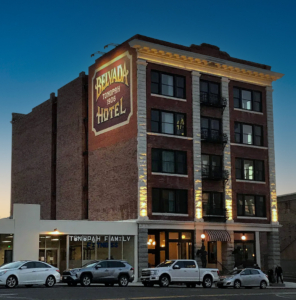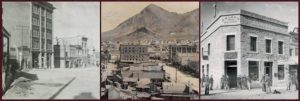Preserving history for generations to come while simultaneously boosting tourism – that’s the goal of Tonopah Main Street: Historical Storytelling, a project that’s using the digital age to promote all of the fascinating facts about the bygone days of Tonopah.
Last May, Tonopah Main Street received $52,400 through the Nye County American Rescue Plan Act grants program to fund the project and following many months of painstaking work, the various components are all starting to fall into place.
Providing an update on the project during the Nye County Commission’s March 5 meeting, Tonopah Main Street Executive Director Kat Galli said there are two official websites established, one specific to the Old Tonopah Cemetery and another highlighting the many points of interest around downtown Main Street. The group is now turning its attention to acquiring plaques that will be placed around town, which will direct people to the websites for further information.
“We have a lot of historical assets and also murals and monuments that have proven in the past to get these people, who are coming through our town anyway, to stop. The whole point is to get them to not stop for five minutes but to spend more time, because more time equals more money,” Galli told commissioners that morning.
“If they can wander our downtown – looking at all these structures, reading about what used to go on here, who possibly lived there, what business was there and then visit the business that is currently there – they are shopping, they are eating and before you know it… it’s getting dark and they are going to get themselves a hotel room,” she continued.
It’s not just about the buildings and artistic attractions that remain in Tonopah, either. The project also shines a spotlight on the Old Tonopah Cemetery, where numerous famed residents of the area are buried. It’s a location that Galli said is already quite popular and the website will undoubtedly increase interest as visitors are able to learn about the lives of those who rest in peace there.
“So hopefully these websites will generate money and not just in the next few years but, because the websites are going to exist forever… hopefully it will keep generating for decades to come,” she said.
Although currently live with lots of information, Galli emphasized that the websites are each a work in progress. Tonopah Main Street will be continually adding content as it is gathered and moving specific features around on the websites, to ensure the best user experience for both computer and mobile device users.
Galli made sure to add that websites have notations explaining that the project was developed using a grant from Nye County.
“We want to make sure everybody knows this was funded by the county and it’s very much appreciated because, quite honestly, this would have taken a lot of fundraising on our part to get to this. It would have been years and years and years down the road to be able to afford all of this, including the plaques that are coming,” Galli remarked.
She also touched on the fact that a bulk of the work that has gone into the Historical Storytelling project has been accomplished by those who, simply wanting what’s best for their community, offered their volunteer efforts.
“I appreciate them very much,” Galli said. “Especially my co-conspirator, Joni Eastley, she’s sitting in the audience and I can’t even tell you how many hours she’s spent volunteering for us, and not just on this project. So if you want good things in your community, step up and volunteer.”
To view the Historical Storytelling project websites visit HistoricTonopah.com and OldTonopahCemetery.com










